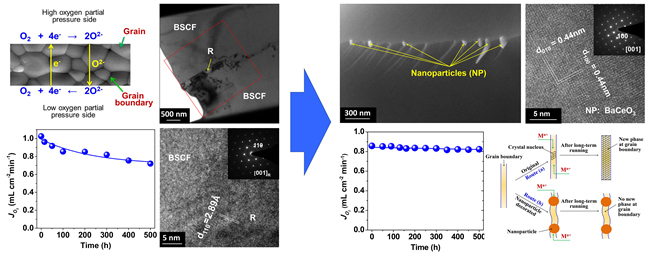Recently, Prof. Weishen Yang’s group of State Key Laboratory of Catalysismade a new progress on stabilizing perovskite membrane at low temperatures. The paper was online published in Nano Letters(DOI:10.1021/acs.nanolett.5b03668).
The application of mixed ionic-electronic conducting (MIEC) membranehas attracted widespread attentiondue to its unique advantages in oxygen separation and catalytic oxidation in membrane reactors.Usually, the operation temperatureof MIEC membrane is higher (>800 °C), which will lead to higher investment on membrane modules and moredifficultyfor sealing modules. Therefore, researchers have devoted a greateffort to decrease the operation temperature to low temperature range (350-650 °C). However, numerous studies showed that the oxygen permeation flux of MIEC membrane decreasedrapidly with time in the low temperature range. In their previous work, thegroup has verified the degradation mechanism of MIEC membranes with stable crystal structures and proposed an effective method to inhibit the degradation of permeation flux (Angew. Chem. Int. Ed.2013, 52, 3232; J. Membr. Sci. 2015, 492, 173.). However, themethod is invalid for those membranes withphase transformations at low temperature, such as Ba0.5Sr0.5Co0.8Fe0.2O3-δ(BSCF)membrane (AIChE J.2015, 61, 3879.).
To solve above problems, the changes of microstructure of BSCF have been investigated intensively under operation conditions and it is found that the degradation of oxygen permeation flux is due to the phase transformation at grain boundaries.In the paper, a new stabilization mechanism was proposed to inhibit phase transformations of perovskite materials by deliberately introducing nanoparticles at the grain boundaries. The nanoparticles act as “roadblocks” that limit the diffusion of metal ions along the grain boundaries and inhibit heterogeneous nucleation and new phase formation. With this novelapproach, a stable oxygen permeation flux(500 h) through a nanoparticle-decorated BSCF perovskitemembrane has been achieved with 10-1000times higher permeation flux thanprevious studies at 550-650 °C.This approach could potentially be extended toother systems that suffer from performance degradation due toa grain-boundary-initiated heterogeneous nucleation phasetransformations.

DICP Researchers Made A New Progress on Stabilizing Perovskite Membrane at Low Temperatures(Photo by Yan LIU and Prof. Xuefeng ZHU)
This work was supported byNatural ScienceFoundation of Chinaand the Key Research Program of the Chinese Academy of Sciences.(Text/Photo by Yan Liu and Prof. Xuefeng Zhu)